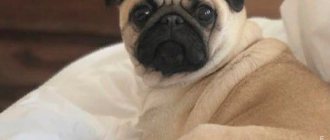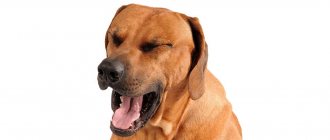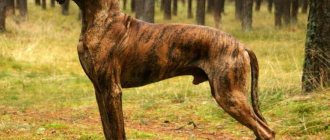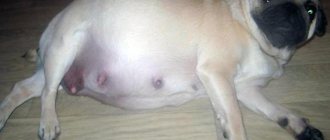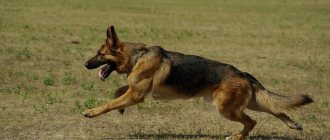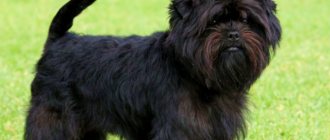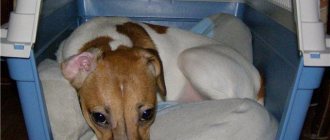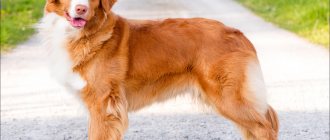Some dog breeds can only be kept by wealthy people. After all, some animals need to be fed intensively, while others, due to their decorative characteristics, are not cheap. A pug is a small dog that previously could only be known. It is believed that the origin story of this cheerful dog originates from sunny China.
True, in those distant times the breed was called “Ha Pa” and “Lo Jie” instead of the current pug. Maybe someone will doubt the Chinese roots of pugs, but there are reasoned explanations for this.
Early manuscripts by Chinese scholars describe varieties of "small dogs with an almost square muzzle." And such characteristics directly indicate the relationship of those animals with today’s decorative pugs.
Miniature pugs can easily be kept in small city apartments. In addition, the animal gets along well with people and other animals. Puppies are not cheap, but there is a chance to buy a pet for your soul at an affordable price.
Origin story
In fact, experts do not have accurate evidence of the real origin of pugs. In addition, there are several plausible theories about the origin of the breed, the most likely being that the dog genus began in China.
The ancient dogs, called Ha Pa by the Chinese, had long hair. The Luo Jie were similar to the Pekingese, but they had shorter hair. Dogs were considered sacred animals and lived only in the homes of noble people in China. Some representatives of that breed lived on the territory of the imperial palace, which explains the privileged position of the dogs.
There are also other global similarities between today's representatives of the breed and their progenitors. In ancient times, pugs did not have such pronounced wrinkles in the muzzle area, but there were folds in the eyebrow area. The Chinese saw certain signs in this - similarities with some hieroglyphs. And such characteristics for ancient people are nothing more than signs that a dog belongs to a high rank. These important features were taken into account when breeding animals in those days.
When trade and diplomatic relations between the continents began to improve, Luo Jie entered European territory. It is believed that it was during those periods that there was a massive surge in the popularity of pugs. Not only important nobles, but also the common population began to have them in their homes. By the way, the dogs imported from China received their name from the Dutch - Chinese Mastiff.
Pugs became a separate, officially recognized breed only towards the end of the 15th century. Back then, miniature representatives of the canine family could be found in the company of noble ladies - at balls and social events. Back then it was very fashionable to carry around a pet with exclusive external characteristics. In addition, pugs kept their owners warm in bed on cold nights.
During the reign of Emperor Napoleon, pugs enjoyed incredible fame. This is due to the fact that Napoleon’s wife Josephine had a favorite – the pug Fortuna, with whom she almost never parted.
But when the French Empire fell, the little dogs fell into disgrace. True, after a while they still regained well-deserved popularity among the ordinary population.
Individuals with modern external characteristics appeared in England. They were formed from representatives of the breed who had:
- ears cropped short;
- tails curled in different directions;
- elongated muzzle.
The flat nose and square format are the result of long-term breeding work. The improved breed was presented at an English exhibition in the 80s. It was then that the first club of breed lovers appeared. A little later, breed standards were established and officially recorded.
Now pugs can be found everywhere - at any international exhibitions and competitions. The breed is common in many countries of the world.
Description and appearance of the pug
Small decorative dogs, even in ancient times, were very revered by the nobility and ruling persons, which is due not only to their balanced character and cheerful disposition, but also to their very original and unique appearance.
Breed standards
Pugs are dogs of a square format, quite compact and proportionally built, having the following established breed standards:
- the head is quite large in size, round in shape, with a short and blunt, square, but not upturned muzzle, on which there are pronounced wrinkles;
- the lower jaw is moderately wide, and the chin area is quite pronounced, which prevents the muzzle from looking poorly developed or too narrowed;
- the area of the bridge of the nose is slightly pronounced, as a rule, absolutely straight, not concave, and without the so-called “snub nose”, with shortened and not curved, relatively wide nasal passages;
- the fold above the nose can have almost any shape, but today it is considered preferable to have a continuous rather than a broken line, which looks the most natural and harmonizes well with the facial part;
- the eyes are large in size, characteristically round in shape, quite protruding, with a very pronounced dark coloration;
- bite with a slight overshot, as well as the front teeth located in a straight line of the lower wide jaw;
- the ears are quite small in size, thin and relatively soft, set high and close to the head;
- the neck area is slightly curved, well developed, strong and quite thick, with a pronounced scruff and a smooth transition from the neck to the withers;
- the body is relatively short and compact, stocky, with properly developed muscles;
- The chest is wide, with well curved and properly developed ribs;
- the tail should not be too long, set high, curled into a ring and well pressed to the body;
- The limbs should be straight and slightly short, and also fairly strong.
The optimal height at the withers for an adult female can vary between 25.0-30.5 cm, and for adult males - 30.5-33.0 cm. The weight of adult dogs should ideally vary between 6-8kg.
Read more about breed standards
Breed color
The main colors of the modern pug are black and silver, as well as beige and apricot, with a very clear contrast with pronounced markings. Currently, breed standards allow o located in the frontal region, on the ears and mask, in moles on the cheeks, as well as a “belt” in the area of the back and claws. The coat should not be too hard, fluffy or long . The coat must be shiny. As a rule, dogs with black coloring have a coarser coat, and very often without a pronounced undercoat.
Important! Black dogs are especially picky at shows. The coat of such an animal should be blue-black, with a beautiful shine, and the most saturated black colors with an absolute absence of red or white are especially highly valued.
Pug character
The main distinguishing feature of a pug dog is not only its unusual appearance, but also its very soft, docile and even somewhat imposing character, which is optimal for anyone who prefers passive relaxation.
By their nature, all pugs are very cheerful and extremely emotional. Such a pet strives to constantly be in the center of attention. As a rule, such a dog treats even strangers very good-naturedly, greeting all guests with a hoarse bark. In the process of showing joy, pugs are able to snort, sniffle and grunt touchingly.
Dog intelligence
Despite their decorative appearance, pugs need proper training, which will teach the dog basic commands and maintain its intelligence at the proper level.
The character of this breed is quite docile, and its intelligence is well developed, but the lack of proper guidance and proper control can make the dog completely uncontrollable. Raising a pug must be started from a very early age, while observing the correct sequence.
At the initial stage, you should establish fairly close contact and trust with the dog . Only after this can you begin to teach such basic commands as “Sit”, “Walk”, “Near”, “Place” and “Fu”. The total duration of all daily training should increase gradually and smoothly, and the innate intelligence greatly simplifies the training of the Pug. With age, pugs become lazier, so the time for exercise and physical activity can be slightly reduced so as not to cause discomfort to the pet.
Lifespan
At first glance, it may seem that such a miniature build and decorative appearance should guarantee the pug an excellent life expectancy. However, this breed belongs to the category of exotics, which have a number of specific problems, so the average lifespan of a pet rarely exceeds thirteen or fourteen years. Also, the overall life expectancy directly depends on the conditions of detention and compliance with the feeding regime.
Return to content
Description of the breed
The pug has a proportional build. Body format is square.
The head breed standard is represented by the following characteristics:
- The large round head is a continuation of the not too long, thick and massive neck. The dog's scruff is moderately pronounced.
- If you look at the dog from the front, you can see that the skull is flat between the ears. The forehead does not protrude at all above the eyebrows;
- the muzzle is short, one might even say flattened. Its width is equal to the width of the forehead. The fleshy nose is colored black. The nasal passages are somewhat shortened, but not curved;
- The straight bridge of the nose is not very pronounced. If it is completely absent, the dog will experience difficulty breathing and cardiac activity;
- wrinkles in the skull area form a symmetrical, beautiful pattern. The location of the folds is near the eyebrows, above the nose;
- The jaw is wide, the chin is pronounced. The lower incisors are arranged in a dense, even line; they overlap the upper row of front teeth. A pug is able to bite an object no more than 3 mm thick;
- brown eyes are located in line with the nose. They are large, convex, round. If a pug's eyes are slanted, almond-shaped, then the individual will be considered defective;
- Small, high-set soft ears lie close to the skull. They can be of two types - “rose”, when the soft tissue is pulled back, revealing the inside of the shells, and “button”, in which case the ears are laid forward, covering the ear canals.
The dog's stocky body is well developed. The length is almost equal to the height of the animal at the withers. The height of an adult is 28-32 cm. Body weight varies between 6.5 -8.2 kg.
The body characteristics of a pug dog are described as follows:
- wide chest with springy, strongly curved ribs. The extreme point of the ribs should be located below the level of the elbows. Towards the back of the dog, the chest line is slightly pulled up;
- the forelimbs are located at a distance, but parallel to each other and perpendicular to the body. From the outer corner, strong muscles form a smooth arc. Shoulders are rounded. The shoulder blades are laid back, forming an acute angle of 45° with the line of the back;
- The hind limbs have a similar arrangement to the forelimbs. True, the hock joints of the dog are significantly pronounced;
- The dog's full croup is rounded. The thick caudal process is located high. It is shaped like a ring and pressed close to the body. Double twist is considered an advantage. The entire tail is covered with short, stiff hair.
Pugs have hard, smooth and shiny hair. The undercoat is dense, but quite soft.
Pug coat color can be:
- black;
- fawn;
- gray-platinum;
- beige;
- deer (a darker stripe runs down the back of a dog with apricot-colored hair).
Representatives of the breed with light-colored fur have a characteristic black mask on their muzzle. Also, light-colored individuals have black markings on the cheeks, ears, forehead, from the withers to the tail.
Dark-colored pugs have much coarser fur than light-colored pugs. If the dog is black, then its skin has a blue tint. Some individuals have no undercoat at all.
Pugs' skin is quite elastic. It doesn't droop, but it doesn't stretch either. Covers fairly developed strong muscles. Pug dogs move elegantly and smoothly. The steps are free and springy.
Each breed has its own special nicknames. After all, the name describes its owner, his character, and emphasizes his virtues. So, for pug boys, nicknames that are easy and clearly pronounced are optimal. For example: Archie, Ricky, Bruce, Jai, Gucci. Pug girls can be called: Ricci, Elsa, Teza, Cleo, Shelly.
Dog standard
Height. The standard height for a female pug is from 25.5 to 30.5 cm, and for a male - from 30.5 to 33 cm.
Weight. The ideal weight for both females and males is a body weight from 6.3 to 8.1 kg.
Head . Massive, round, but its shape is not apple-shaped. The bones of the head and facial skull are not pronounced.
Muzzle. The pug's muzzle is not angular, blunt, and short in length. There is no snub. The wrinkles on the muzzle are deep and large.
Teeth. The pug's bite is a light, dense snack. The lower jaw is quite massive. The teeth along the incisors are lined up in a single line.
Paw size. The length of the paws should be moderate. The development of muscles in the limbs is allowed, which can create the appearance of “crooked paws.”
Tail . The pug's tail is set high, rounded, and pressed to the croup (the back of the dog's body). The ideal is to have two curls.
Eyes. Eye color is dark. The pug's eyes are quite large in size. The eye shape is round. The look has a questioning tone. In a calm state, the dog’s eyes sparkle; when excited, they burn with fire.
Ears. The ears of this breed are small, soft, and thin. They feel velvety to the touch. There are two types of pug ears:
- The first type is “rose”. The ear is raised on cartilage and is small in size. A characteristic feature of this variety is the retraction of the ear posteriorly, which opens the dog’s ear canal;
- The second type is “bud”. With this type, the ear is directed forward, closing the ear canal. The ear is also stuffed forward. The angle of the ear is directed towards the eye. This ear looks pressed to the skull. At exhibitions, preference is given to this type of ear.
You can also find in the literature the names “button”, “button” or “button”. They are synonymous with the "bud" type.
Wool. The pug's coat is short, soft, straight, and fine. It is not fluffy or tough.
Color. The standard colors are the following:
Yellow-brown - beige (“Fawn”);
Yellow-brown with a silver tint - silver (“Silver Fawn”);
Yellow shades with a smooth transition to orange - apricot (“Apricot”);
Black.
Inclusions of a different color and their location on the pug’s body:
- Mask on the face.
- Ears.
- Moles on the cheeks.
- "Diamond" on the forehead.
- "Strap" on the back.
- Claws.
Character
The pug is a noble, affectionate, friendly and balanced dog. She has a cheerful disposition and love of life. For the most part, pugs are loyal to all members of their family. It is extremely rare to find cowardly, dissatisfied and aggressive individuals. But for the most part, a dog’s anger is due to improper upbringing.
Pugs get along well under the same roof with children. Also, representatives of the dog family get along well with other family pets. Small dogs love attention very much, so they will always try to please their owner and be the first in everything.
Fans of the pug breed claim that dogs with dark coat color are more alert and balanced. Light individuals have a simpler and kinder character.
Care and maintenance
The pug has a fairly compact size, so keeping such an animal in an apartment does not cause any particular difficulties for humans. True, street walks with a pet should be at least 1 hour at a time. And there should be at least two walks per day.
The pug requires almost no physical activity, although running gives the dog pleasure. The active part of the walk should take no more than 30 minutes. If the weather is too cold or, conversely, hot, then you can limit running activity to 10 minutes. The rest of the time, walk slowly, take a walk, or just relax.
The dog can be trained to relieve itself at home. To do this, you should determine the location of the toilet, the type (diaper, tray, newspaper), and show it to the puppy.
A pug should be housetrained from an early age. If the case is successful, praise the dog. If your pet fails to pee in the designated area the first time, then there is no need to scold him for it. The owner should be patient and show the toilet every time the puppy goes by.
Pugs shed 1-2 times a year. Lasts 2-3 weeks. If the room where the pet lives is dry and excessively warm, the fur can fall off all year round. It is important to provide the dog with a comfortable atmosphere in the living space:
- air temperature – 20-23°C;
- humidity at 45-65%.
If all the conditions are met, but the dog’s hair continues to fall off, you should pay attention to the frequency of washing. According to the rules, she does not require frequent water treatments using shampoo. It is enough to bathe your pet 2-3 times a month. You can use detergents and cosmetics even less often - once a month is enough.
You need to brush your dog with a special brush once a week. Thus, dead hairs and skin flakes are removed, and subcutaneous blood circulation is stimulated. During the shedding period, the amount of brushing should be increased.
Excessive hair loss can also be caused by body problems: the appearance of helminths or subcutaneous parasites, disorders of the digestive system, and pathologies of other organs.
On the face, food particles or dirt from the street may remain in the folds. This may cause an unpleasant odor. A couple of times a week you need to wipe the dog’s skin with cotton pads soaked in boiled water. After this, wipe the fold dry with a towel. You cannot wipe away wrinkles every day. This can cause the skin to become dry and lead to infection.
The dog's eyes are quite healthy. Sometimes you can notice the release of a whitish liquid from the corners - this is the release of dust and dirt that has accumulated on the shells during the day. The liquid should be carefully removed with a damp cotton pad or cloth.
The dog's nails need to be trimmed once a month. If you do not treat the claws, they will painfully dig into the dog’s fingers, causing discomfort.
If suddenly redness, large suppuration, or a whitish spot appears in your pet’s eyes, you should immediately contact a specialized clinic; you should not carry out independent treatment at home. The same should be done if a dog is found to have a tick on its body or in its ears. Delayed assistance may not save your pet from encephalitis.
Feeding
Pugs have a tendency to be overweight. Therefore, you should carefully monitor your pet’s diet. You can feed your animal both ready-made food and home-cooked food. There is one rule: you cannot mix two types of feeding at one time.
If the choice is made in favor of ready-made food, then it is better to give preference to premium products, for example, Royal Canin. They already contain the necessary vitamins and minerals, and are also balanced according to all the rules.
When feeding your dog natural foods, you should pay attention to healthy foods:
- lean meat (beef, venison, rabbit);
- offal (kidneys, liver, heart), doused with boiling water;
- cereals (rice, buckwheat);
- fresh vegetables and fruits;
- fermented milk products;
- sea fish, provided there are no bones in it.
You should not give your pug:
- sweets;
- baked goods;
- cocoa products;
- legumes;
- fatty, spicy, salty and smoked foods;
- river fish;
- bread and pasta;
- oatmeal;
- any kind of bones.
All of the listed products will disrupt the proper functioning of the gastrointestinal tract. Sweets and flour products will provoke the formation of excess weight.
What to feed a puppy
If an adult pug should eat 1-2 times a day, then for puppies the meal plan is slightly different:
- After switching from mother's milk to familiar foods, you need to feed the puppy 6 times a day in small portions.
- After 2 months, the dog is fed 5 times a day. The serving size increases by 100-200 grams.
- From 4 to 6 months, the puppy eats 4 times a day.
- Before reaching the age of one year, the dog requires 3 feedings a day.
- After a year, the stage of active growth of the animal ends. The pug switches to the adult dog mode - 1-2 meals a day.
It is best to feed pug puppies with ready-made premium and super-premium products. Manufacturers have already taken into account all the needs of a growing organism and balanced the composition. In addition, pugs are prone to allergic reactions, and among premium nutrition you can easily find holistic ones.
How to care for a pug - features
Caring for a pug is a whole range of activities, each of which plays an important role in maintaining the health and good mood of the dog. New dog owners may think that pugs are difficult to care for - this is not entirely true! Do not deprive yourself of the pleasure of finding a faithful friend and companion, an affectionate and playful pet, like the dogs of this decorative breed. For all happy owners and those who are just looking for information about the pug breed, we have collected everything about the care and education of these small dogs.
Pug coat care
The coat of dogs of this breed is double, thick, and sheds constantly. It is important to get your pug used to grooming from a very young age. To do this, puppies are brushed at least once a week. A hairbrush for a pug should become a familiar accessory that the dog is not afraid of.
Older dogs require more regular brushing to remove dead hair. Pugs are brushed every other day or at least twice a week. A comb or brush should be able to handle thick hair. It is best to comb your pug first with a wide-toothed comb, and then finish the job with a comb-mitten.
How to bathe a pug correctly
The first question that worries owners of dogs of this breed is: “How often can you bathe a pug?”
This is one of the dog breeds that loves bathing, but you need to bathe your pug once every three weeks. This procedure will relieve your pet of unpleasant odors, help free the fur from dead hairs and keep the skin sufficiently moisturized. Small puppies can be bathed in a sink, while older dogs can use a bathtub.
Pugs have very sensitive skin, and the breed is prone to allergic reactions, so it is important to choose the right bath product. Don’t even try to use your own shampoo for these purposes; purchase products from pet stores and veterinary pharmacies. Shampoos with a pH level of 6.5 to 7.5 are suitable - always check this information on the packaging. At the end of the procedure, use special conditioners for dogs.
Important: soap solution accumulates in the dog’s folds, so you need to thoroughly rinse each fold after bathing and wipe it dry.
Pug folds - how to care for them
The folds on the facial part of the dog’s muzzle not only make the pug’s appearance so recognizable and endearing, but also require special care. Let's talk about how to properly care for your pug so that these folds do not become a problem for your pet.
Facial folds should be cleaned weekly of saliva, food debris, and dirt. All of this can easily accumulate in your Pug's wrinkles, causing unpleasant odor and skin irritation.
How to properly clean folds:
- Soak a cotton pad in warm boiled water.
- Gently rub the pad over all the creases around the nose and eyes.
- Keep the swab away from your dog's eyes, mouth, and nostrils.
- After drying, dry each crease with a clean, dry towel. Do not leave folds wet!
- Repeat the procedure at least 1 time per week.
Important: after each feeding, clean the folds on the face from food debris with a damp towel.
Caring for claws, ears and eyes
Your Pug's ears should be checked regularly and cleaned weekly with an ear cleaning solution to remove accumulated dirt. It is unacceptable to use cotton swabs for this, as this can injure the eardrum. Cleaning is done with a cotton pad or swab, avoiding its deep penetration into the ear canal.
Because the breed is not very active, pugs' claws do not have time to grind down properly. They have to be trimmed with a special nail clipper. You can trim the nails as they grow back at home, or have your pug professionally groomed at a grooming salon or veterinary clinic.
The eyes of pugs require special attention from owners, as they have a special structure - protruding. This shape of the eyes of brachycephalic dog breeds makes them vulnerable to various types of injuries and pathologies, one of the most serious is proptosis (prolapse of the eyeball). To prevent this pathology, owners should take care of the pug's eyes and take care to reduce the risk of injury to the pet.
Oral hygiene
Toy dog breeds are prone to caries, so special attention should be paid to oral hygiene. If dental plaque is not removed in a timely manner, it leads to the destruction of tooth enamel, infection and inflammation of the gums, and tooth loss.
Dental and oral care consists of brushing the teeth with a special dog brush and using an effective toothpaste. You need to get used to this procedure from a very early age, as soon as you take the puppy into your home. For those dogs that cannot tolerate such cleaning, there are special cleaning sprays.
In addition to daily teeth cleaning, you need to see a veterinarian once a year, who, if necessary, will professionally clean your teeth from plaque and tartar. This procedure is painless for dogs and is performed under mild sedation.
Training and education
Miniature dogs are very attached to their owners. They also always try to please their owner. Therefore, training a pet will bring pleasure not only to the animal, but also to the dog breeder.
At a young age, during educational play, a dog may try to misbehave, but you should not scold it for this. For the sake of a piece of treat or a kind word (look) from the owner, pugs are ready to complete assigned tasks.
Diseases and life expectancy
The life expectancy of small dogs is 13-16 years. Under good living conditions, a pet can live several years longer than the average upper limit.
Diseases to which representatives of the pug breed are susceptible:
- obesity;
- dental diseases;
- infections that occur in skin folds;
- respiratory tract pathologies;
- ophthalmological problems;
- seasonal allergies.
It is noted that this type of breed is prone to epileptic seizures.
Estrus, mating, pregnancy and childbirth
Breeding pugs is not recommended for beginners. After all, this process has a lot of subtleties:
- Before mating, you need to take care to rid your pet of excess body weight. A month before mating, the dog should be given antihistamines.
- The first mating is allowed at the age of no earlier than 10 months. The more the dog gets stronger before mating, the better. Therefore, some breeders believe that 10 months of age is too early for such a serious process.
- After the heat comes, you need to wait 10-15 days, and only then breed. This is the best time to fertilize a bitch.
- In order for the mating to be successful, it is necessary to give the dogs time to get to know each other. For successful fertilization, mating is repeated after three days.
Incorrect crossbreeding can result in animals with characteristics that are far from standard.
During pregnancy, the bitch should be provided with adequate nutrition. There is no need to increase the number of feedings; you just need to supplement the diet with various microelements.
Your dog may need help during the birthing process. Therefore, a pregnant pug should be observed by a specialist. The owner must listen to the advice of the veterinarian if he wants to get healthy offspring from his ward.
Development and growth rate
As a toy breed, Pugs are not very tall. Average animal height:
- Boys - 30-35 cm at the withers.
- Girls – 25-30 cm at the withers.
“Ideal weight” varies slightly depending on the standards of cynological associations:
- Canadian club: boys – 8.1 kg, girls – 6.3 kg.
- American Club: boys – 8.2 kg, girls – 6.4 kg.
In body shape, pugs are “square dogs”: the height at the withers and the length of their bodies are approximately equal. These are dense, well-built, muscular animals with a stocky build. At the same time, a puppy with normal weight has a free and easy gait.
In order for the kitten to develop fully and not acquire diseases and pathologies, you should adhere to simple rules:
- Set a strict diet and feeding schedule for the dog. It is best to consult a veterinarian.
- Make sure your dog leads an active lifestyle. Walks with the puppy should take at least 1 hour. Joint jogging with the owner, playing ball or frisbee are required. Another form of staying in great shape is swimming. However, not all pugs love water activities.
- Track the puppy’s weight, compare personal indicators with the average. Do not ignore strong deviations.
- Visit a veterinarian for a preventive examination at least once every six months.
If you follow these general rules and individual recommendations from a specialist, you can provide your pug with a happy life of at least 12-15 years.
How to choose a puppy
It is clear that a puppy with excellent characteristics can only be purchased in specialized nurseries. But everyone knows that puppies in elite clubs are not cheap. Thus, purebred pug puppies are valued at 15-45 thousand rubles. In this case, the future owner will receive documents for the animal and a veterinary passport.
The best clubs in Russia specializing in breeding and selling pugs:
- Loyal Friend in Moscow;
- My Universe in Nizhny Novgorod;
- Nevsky Magnat in St. Petersburg;
- YANIN CHIC MANIFIC in Perm;
- GREYT JOY in Arkhangelsk.
If you decide to buy a pug from random people, then there is a big risk of purchasing a sick animal for a nominal fee. Physical deficiencies may not appear immediately - as the dog grows older. In addition, there is a chance to get a pet with a bunch of other hereditary diseases - after all, no one can guarantee that all the puppy’s ancestors were pure representatives of the breed.
Before choosing a specific individual, you should decide for what purpose the dog is needed:
- to participate in breeding;
- as a future winner of exhibitions and competitions;
- for living in a house, and nothing more.
In the first two cases, you should choose an animal based on its compliance with established standards; these individuals are quite expensive. Rejected pugs may have minor defects in their appearance (in color, ear placement, etc.), but will be sold at several times cheaper.
Experienced breeders believe that the best time to move a pet is 2-2.5 months. During this period, the puppies have already received some of the necessary vaccinations, and they no longer need their mother as much as in the first 1-1.5 months. Animals at this age are already socialized and are ready for new acquaintances.
Comparison of breeds
Each dog has its own advantages. People who are planning to get a pug compare the breed with other similar breeds.
Take, for example, the pug and the French bulldog. The differences between the breeds are in body weight (the weight of a Frenchie is almost twice that of a pug), height (Frenchies grow up to 38 cm), and the location of the ears (the French have erect ones). By nature, both of these breeds are friendly, affectionate, intelligent, and also tolerant of children.
How old do pugs grow?
The period of active growth and weight gain in pugs occurs in the first 12 months of life. The highest growth rates are the first two months. Babies grow and develop. During this period of time, the pug's weight changes every day. Puppies quickly double and triple the weight they were born with.
Dogs of this breed reach their maximum weight and height at 9-12 months. But this is an average value. It is difficult to predict what size pugs will grow to by the age of 1 year - this indicator is individual for each dog. Some individuals continue to grow up to 15 months, and there are pets that grow up to one and a half years.
Advantages and disadvantages
The pug has a number of advantages and some disadvantages:
| Characteristic | pros | Minuses |
| Shedding | With sufficient humidity and temperature, it takes place 1-2 times a year. | Monitor humidity and prevent skin diseases |
| Contents in the apartment | Fits | Requires care and toilet training |
| Pug and children | They get along and play | |
| Get along with other animals | Friendly with all living beings | |
| Care | Minimal | |
| Security qualities | Can't cope, although he tries to bark at the sight of danger | |
| Physical exercise | Virtually not required | |
| Training | Gives in well | |
| Agility | Doesn't fit |
Overall, the pug is an excellent companion and friend. Loves affection and is devoted to his owner. The breed is suitable for passive people, as the dog requires almost no physical training.
How to choose a dwarf pug?
In our country, American low-growing Lo-Shi pugs have not yet become widespread, so in order to get a real puppy of this breed, you need to be prepared for the fact that you will have to order it from overseas.
There are only three official breeders of these pugs in the world, and they all live in the United States.
You can contact them and arrange a purchase directly by email:
- Rebecca Manns
- Donna Marshall
- Jerry John
Also, when searching for Lo-Shi puppies, services such as puppyfinder.com and hoobly.com can help. Such a purchase will cost from 25,000 rubles and more.
CAREFULLY!
Most advertisements for the sale of dwarf pugs in our country are fake to varying degrees. Real scammers will simply slip in an ordinary pug puppy, passing it off as a miniature one.
But there are also two other options that can hardly be called a real deception, although such dogs have nothing to do with Lo-Shi pugs.
The first option is quite simple - breeders seeking to produce miniature pugs simply crossbreed the smallest puppies in the litter. Often, such breeding actually results in tiny dogs, but they have many health problems and live much shorter lives than they should.
The second option is the so-called designer dog breeding, which is gaining increasing popularity. By crossing pugs and chihuahuas, breeders get dogs with characteristics close to the Lo-Shi mini-pugs.
The problem is that the results of such hybridization are unpredictable, and puppies can inherit the best traits of both parents, as well as the worst. In addition, the traits obtained in this way are not stable and will not be fully transmitted to the next generation.
